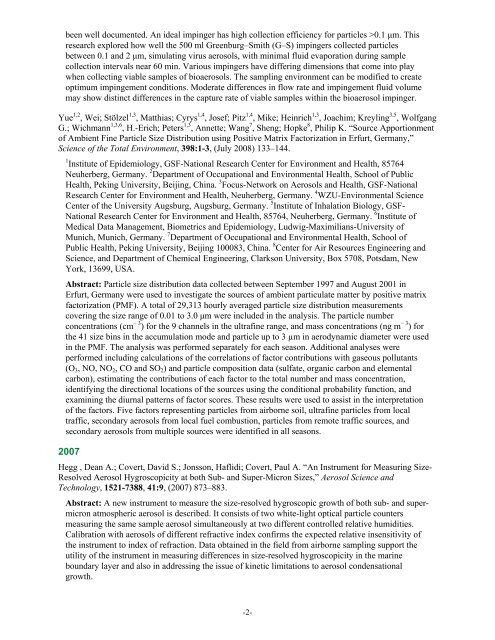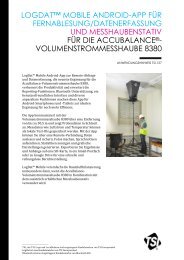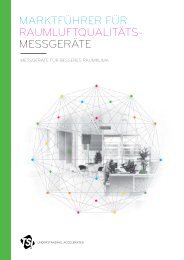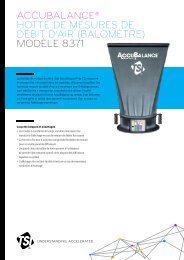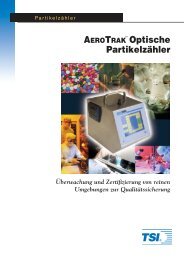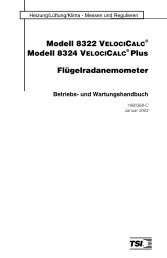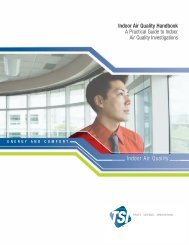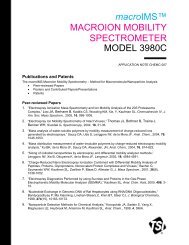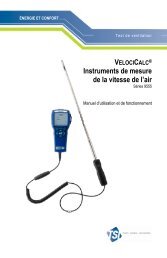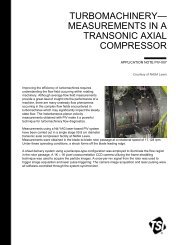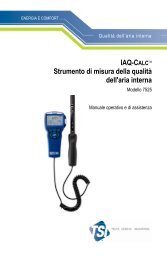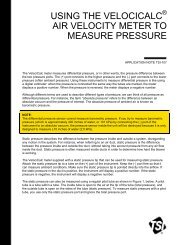Model 3340 Laser Aerosol Spectrometer Bibliography - Tsi
Model 3340 Laser Aerosol Spectrometer Bibliography - Tsi
Model 3340 Laser Aerosol Spectrometer Bibliography - Tsi
Create successful ePaper yourself
Turn your PDF publications into a flip-book with our unique Google optimized e-Paper software.
een well documented. An ideal impinger has high collection efficiency for particles >0.1 μm. This<br />
research explored how well the 500 ml Greenburg–Smith (G–S) impingers collected particles<br />
between 0.1 and 2 μm, simulating virus aerosols, with minimal fluid evaporation during sample<br />
collection intervals near 60 min. Various impingers have differing dimensions that come into play<br />
when collecting viable samples of bioaerosols. The sampling environment can be modified to create<br />
optimum impingement conditions. Moderate differences in flow rate and impingement fluid volume<br />
may show distinct differences in the capture rate of viable samples within the bioaerosol impinger.<br />
Yue 1,2 , Wei; Stölzel 1,3 , Matthias; Cyrys 1,4 , Josef; Pitz 1,4 , Mike; Heinrich 1,3 , Joachim; Kreyling 3,5 , Wolfgang<br />
G.; Wichmann 1,3,6 , H.-Erich; Peters 1,3 , Annette; Wang 7 , Sheng; Hopke 8 , Philip K. “Source Apportionment<br />
of Ambient Fine Particle Size Distribution using Positive Matrix Factorization in Erfurt, Germany,”<br />
Science of the Total Environment, 398:1-3, (July 2008) 133–144.<br />
1 Institute of Epidemiology, GSF-National Research Center for Environment and Health, 85764<br />
Neuherberg, Germany. 2 Department of Occupational and Environmental Health, School of Public<br />
Health, Peking University, Beijing, China. 3 Focus-Network on <strong>Aerosol</strong>s and Health, GSF-National<br />
Research Center for Environment and Health, Neuherberg, Germany. 4 WZU-Environmental Science<br />
Center of the University Augsburg, Augsburg, Germany. 5 Institute of Inhalation Biology, GSF-<br />
National Research Center for Environment and Health, 85764, Neuherberg, Germany. 6 Institute of<br />
Medical Data Management, Biometrics and Epidemiology, Ludwig-Maximilians-University of<br />
Munich, Munich, Germany. 7 Department of Occupational and Environmental Health, School of<br />
Public Health, Peking University, Beijing 100083, China. 8 Center for Air Resources Engineering and<br />
Science, and Department of Chemical Engineering, Clarkson University, Box 5708, Potsdam, New<br />
York, 13699, USA.<br />
Abstract: Particle size distribution data collected between September 1997 and August 2001 in<br />
Erfurt, Germany were used to investigate the sources of ambient particulate matter by positive matrix<br />
factorization (PMF). A total of 29,313 hourly averaged particle size distribution measurements<br />
covering the size range of 0.01 to 3.0 μm were included in the analysis. The particle number<br />
concentrations (cm − 3 ) for the 9 channels in the ultrafine range, and mass concentrations (ng m − 3 ) for<br />
the 41 size bins in the accumulation mode and particle up to 3 µm in aerodynamic diameter were used<br />
in the PMF. The analysis was performed separately for each season. Additional analyses were<br />
performed including calculations of the correlations of factor contributions with gaseous pollutants<br />
(O3, NO, NO2, CO and SO2) and particle composition data (sulfate, organic carbon and elemental<br />
carbon), estimating the contributions of each factor to the total number and mass concentration,<br />
identifying the directional locations of the sources using the conditional probability function, and<br />
examining the diurnal patterns of factor scores. These results were used to assist in the interpretation<br />
of the factors. Five factors representing particles from airborne soil, ultrafine particles from local<br />
traffic, secondary aerosols from local fuel combustion, particles from remote traffic sources, and<br />
secondary aerosols from multiple sources were identified in all seasons.<br />
2007<br />
Hegg , Dean A.; Covert, David S.; Jonsson, Haflidi; Covert, Paul A. “An Instrument for Measuring Size-<br />
Resolved <strong>Aerosol</strong> Hygroscopicity at both Sub- and Super-Micron Sizes,” <strong>Aerosol</strong> Science and<br />
Technology, 1521-7388, 41:9, (2007) 873–883.<br />
Abstract: A new instrument to measure the size-resolved hygroscopic growth of both sub- and supermicron<br />
atmospheric aerosol is described. It consists of two white-light optical particle counters<br />
measuring the same sample aerosol simultaneously at two different controlled relative humidities.<br />
Calibration with aerosols of different refractive index confirms the expected relative insensitivity of<br />
the instrument to index of refraction. Data obtained in the field from airborne sampling support the<br />
utility of the instrument in measuring differences in size-resolved hygroscopicity in the marine<br />
boundary layer and also in addressing the issue of kinetic limitations to aerosol condensational<br />
growth.<br />
-2-


